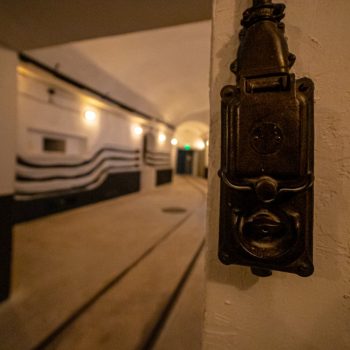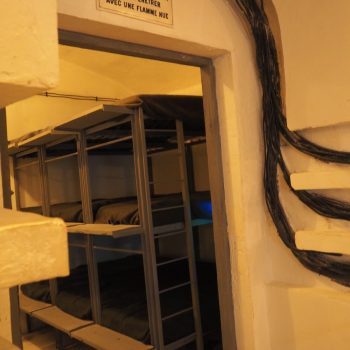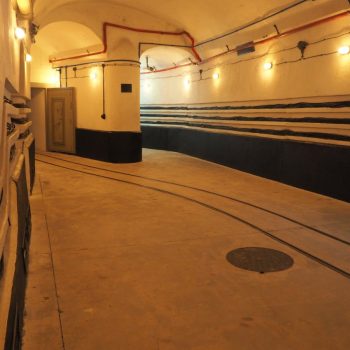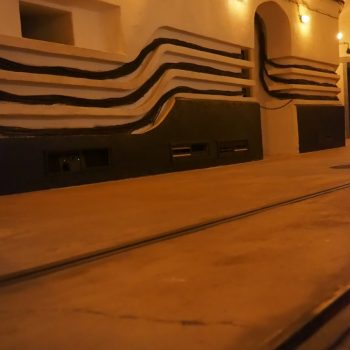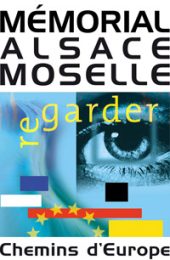Step by step
Step by step
- Home
- The Memorial
- Step by step
THE ALSACE-MOSELLE PORTRAIT GALLERY
TAKEN BACK AND FORTH
BETWEEN THE TWO COUNTRIES
In the first room of the memorial, you will discover a very large space, that appears to be the Gallery of portraits.
With your audio-guide, available in three languages, you will go through seven decades of a very tormented history. You will hear the voices of dozens of people, either anonymous or identified, speaking their own languages. These witnesses of the complex history of these regions at the border will tell you about their own experience.
You will be immersed in a very particular atmosphere, created by the polyphony, while maps, photos and documents address the history of Alsace-Moselle between 1870 and 1939.
THE WAR IN ALSACE MOSELLE
Next you enter into a small space. Hitler is barking: On 1st September 1939, the German army invaded Poland.
You enter the train station of a reconstructed village. On the wall you see tourism posters as well as evacuation orders. You settle into a train car filled with suitcases and personal effects. A projection appears on the compartment wall, presenting the images of the evacuation of 611,000 Alsatians and people from Moselle towards the Southwest of France. On the other side of the train, a hallway leads to the depths of a Maginot Line fort. Now, you see white walls with electric cables, railway on the floor, dormitories and bulletproof doors…
The diffusion of the orders gave to the enlisted men, extract of speeches, images of fights or day-to-day life in the Maginot line, will immersed you in the very particular atmosphere of the “Phony War”.
THE DE-FRANCISATION
OF ALSACE-MOSELLE
In this passage, street signs are hung on the wall, first with French names, and then renamed in German. On the ceiling you see flags that, one after the other, change from the tricolour stripes of the French flag to the Swastika…
The powerful noise of boots makes this worrying atmosphere feel even heavier.
COOPERATION AND FORCED ENLISTMENT
Now, you arrive before a building characterized by German architecture. Slanting forward slightly, we cannot avoid its imposing structure and we are plunged into an oppressive atmosphere that is part administrative, part prison-like.
Here and there, offices bring to life the various phases of the strict ordering of the local population, including forced enlistment, with the ultimate terror of the Struthof Camp in perspective.
Resistance and repression
Then, the tour leads you towards a concentration camp: wires, barracks, weak lightening and watchtowers…
The very grey atmosphere of this room, reinforced with pictures and documents, try to explain the very sensitive history of this region, especially the resistance and the smugglers networks, that helped people to escape Alsace and Moselle.
RESISTANCE OUTSIDE OF ALSACE AND FULL-SCALE WAR
You wander now in a passageway above the ground. The pine trees of the Vosges forest are here to remind you of the smugglers networks that operated in this landscape… And now all around you see the war. The ground, destroyed by bombardments, is covered with all types of bits and pieces : bicycles, wrecked cars, gas cans…The bombers invade the sky. A house crumbles. Despite this, the films projected onto the wall show the German retreat and the D-Day landing. Fortunately, Liberation is close. Your path takes you to a silent soundproof white holding room. No more noise of war; it’s the moment of truth.
From here, you enter into the Eu-Phoria space, and you are quickly strike by the bright colours and loud sounds of this room that fill this place with life.
This space is very interactive and invite you to become a full participant.
THREE SPACES DEDICATED TO THE EUROPEAN SAGA
The Journey of Europe from 1945 to the Present: All the stages of European construction are evoked and the themed stations invite you to stop at each specific event; for example, a giant-format newspaper which, by using a simple movement of the hand, invite you to read an international press revue that followed the failure of the European Defence Community. A statue of Erasmus brings to mind the Erasmus exchanges and cultural Europe. Also present: moon vehicles that retrace the space race…
The Globe: A cartography space to understand Europe on all its different scales (Schengen, Council of Europe, GDP,….)
There is the Forum where, thanks to a tablet, you can interact with European challenges and become a participant in Europe’s destiny. Then, for the finale, there is a 7-minute-long film that is projected on 3 walls and suggests that another Europe is possible.
